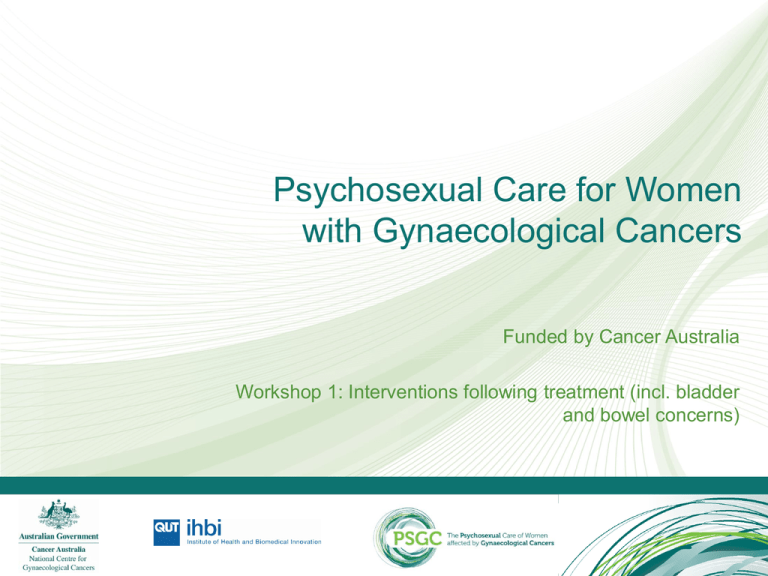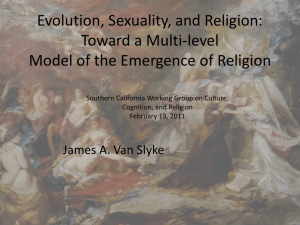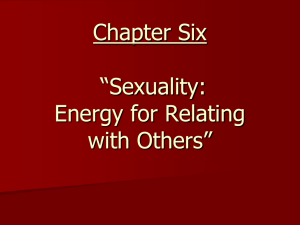
Psychosexual Care for Women
with Gynaecological Cancers
Funded by Cancer Australia
Workshop 1: Interventions following treatment (incl. bladder
and bowel concerns)
Introduction
• Treatment for a gynaecological cancer (GC) can alter a
woman’s behaviours, attitudes and feelings towards
sexuality and intimacy.
• Health professionals require knowledge and skills to
minimise the risk of these concerns, and to effectively
treat them should they occur.
• The aim of this project was to develop a psychosexual
care framework and educational resource to improve
health professionals’ skills and confidence in providing
effective psychosexual care.
Activity: Dispelling common myths about
sexuality
•
•
•
•
•
•
•
Sex causes cancer.
Older people aren’t interested in having sex.
People with cancer don’t want to have sex.
Discussing sex isn’t nice.
People who want to know about sex will ask.
People who are dying are not interested in sex.
Sexuality is only about intercourse.
Session objectives
• Identify dimensions of sexuality
• Identify the common psychosexual effects of diagnosis and
treatment for gynaecological cancer
• Describe principles for communicating about sexuality
• Outline a model for undertaking a psychosexual assessment
• List principles for psychosexual care
Activity: What is sexuality?
• How do you define sexuality?
• Who or what has shaped your definition of sexuality?
What is sexuality?
• The term 'sexuality' has any number of meanings.
– It can be linked with loving relationships and intimacy
– It can be associated with physical appearance and interpersonal
behaviours
– It can be associated with sexual activity
What is sexuality?
• a person's behaviours, desires, and attitudes related to sex and
physical intimacy with others
National Cancer Institute
http://www.cancer.gov/dictionary/?CdrID=476620]
Factors influencing an Individual’s Sexuality
• Sexuality can be influenced by a range of social, cultural,
psychological and biological factors
Defining sexual health and sexual
dysfunction
• Sexual health is a state of physical, emotional, mental and social
well-being relating to sexuality. It's not merely the absence of
disease, dysfunction or infirmity.
• Sexual dysfunction is 'the various ways in which an individual is
unable to participate in a sexual relationship … he / she would wish'.
World Health Organization
How common is sexual dysfunction?
• Experiencing sexual dysfunction is relatively common in the
community
• A survey of Australian women reported that 70% experienced sexual
difficulties (including the inability to orgasm and not feeling like sex)
in the year before the survey
Richters J, Grulich, A.E., Visser, R.O., Smith, A.M., Rissel, C.E. (2003).
Australian and New Zealand Journal of Public Health Volume 27,
Issue 2 , pp. 164-170
Gynaecological cancer and sexual
dysfunction
Sexual dysfunction can occur:
• in the months preceding a definitive diagnosis, due to:
– the onset of disease related symptoms including vaginal bleeding
and discharge, pain and fatigue
• during treatments as a result of:
– functional and physiological effects of surgery, radiotherapy,
chemotherapy or other treatment,
– psychological and social effects of a diagnosis and bodily changes
• following completion of treatment, due to:
– longer term physiological, psychological and social sequelae of the
disease and treatments.
Causes of sexual dysfunction in
gynaecological cancer
• Anatomical changes to the vagina, resulting in vaginal
stenosis, or decreased lubrication
• Hormonal changes, resulting in menopausal symptoms
including dry vagina
• Alterations to reproductive function, resulting in changes to
fertility
• Altered bowel and bladder function, resulting in concerns
about incontinence
• Functional limitations, resulting from treatment related fatigue,
or lymphodoema
• Psychosocial effects, for example concerns about body
image, fear of pain, and altered roles and relationships
Case study: Norma
• Watch the video and consider the following questions:
– What are the possible psychosexual effects associated with
Norma’s cancer and cancer treatment?
– What communication skills should be utilised to approach a
discussion about sexuality following her diagnosis and treatment
– How would you approach a psychosexual assessment?
Norma’s Story part 1
Meet Norma (1:20)
Principles for Communicating with People
affected by Cancer
about Sexuality
1. Prepare for discussions
• Recognise the difficulty of initiating discussion about sexuality.
• Take a positive stance, reinforce that sexual problems following
cancer treatment are normal and expected, but are usually
temporary.
• Comfort in discussing sexuality improves with practice.
2. Time your discussion
• Sexual difficulties may arise at different points in the recovery process.
• Women need to develop rapport and trust with health care
professionals before discussing sensitive matters.
• Ensuring that sexuality is on a checklist of questions gives women
permission to discuss concerns.
3. Use good communication skills
• Convey a non-judgmental value orientation.
• Ask clear, open-ended questions and allow adequate time for the
woman to find words to respond.
• Check with the woman that she understands what you are asking and
seek clarification that you understand.
• Be alert to non-verbal cues of discomfort or distress.
3. Use good communication skills – Some
examples
• “Now that we’ve talked about how you are managing at home after
the treatment, I would like to ask some questions about how things
are going with your sexual relationship. Is that OK with you?”
• “I’m really pleased to hear that the treatment side-effects are settling
down. I find for most women at this stage another area of concern
may be sexual function. Are there any issues there that you would
like to discuss?”
4. Use appropriate language
• Check the couple’s understanding of sexual/reproductive anatomy
and function and correct misunderstandings.
• Use simple language rather than formal anatomical terms.
• Check with the woman/couple that your terminology is
understandable and try to use the terminology of the woman/couple.
• Diagrams are often helpful.
5. Normalise and validate
• Seek permission from the woman to raise these matters and
normalise the incidence of post-treatment sexuality changes.
• Questions about sexual function should be as routinely asked as
questions about pain, bladder and bowel function and all other
treatment side-effects.
5. Normalise and validate: An example
• “I always ask how things are going with sexual relationships
because it’s really very common to have difficulties after treatment.
Is that something you would like to talk about?”
6. Sensitively address myths and misconceptions
• Myths and misconceptions about sexuality are common and may
impede resumption of sexual activity, e.g.,
– Sex causes cancer
– Sex will be harmful
• Validation of concerns and encouragement to communicate with the
partner and with health professionals may assist women in
dispelling myths.
7. Determine preferences for involving
partners in the discussion
• Conduct initial assessment with the woman alone. Discuss her
wishes for involvement of the partner.
• Not all women will wish to involve their partner in this process, e.g.,
– If there is a history of violence, infidelity or sexual abuse in the
woman’s current or past relationships
– If there are cultural or religious taboos around discussing matters
of sexuality, the woman may feel more comfortable discussing
sexuality issues on her own.
Case Study: Norma
• What potential barriers are there to communicating with Norma
about her sexuality?
• What communication skills does the social worker use to facilitate
discussion with Norma about her sexuality?
Norma’s Story part 2
Overcoming Barriers (4:18)
Undertaking a Psychosexual
Assessment
Undertaking a Psychosexual Assessment
• Comprehensive assessment of psychosexual concerns needs to
include an understanding of all intimate behaviours and practices for
giving and receiving sexual pleasure/satisfaction; not just
intercourse.
• Sexuality is multidimensional, encompassing concepts of body
image, self-esteem, intimacy, emotional adjustment, interpersonal
communication and a diverse range of sexual behaviours.
Ex-PLISSIT Model for assessment
• Permission: Give permission for the woman to have sexual feelings /
relationships and normalise this.
– “Many women diagnosed with cancer find that it has an impact
on their relationships and their interest in sex. Is it ok if we
discuss this issue?”
Ex-PLISSIT Model for assessment
• Limited Information: Provide limited information to identify the effect
of the cancer / treatment on sexuality. Correct any misconceptions,
dispel myths, provide accurate information.
– “Treatment side effects often have a big impact on sexual
activities. You mentioned that you started having intercourse
again but it is still painful after treatment. How is this pain
affecting your sex life?”
Ex-PLISSIT Model for assessment
• Specific Suggestions: Make specific suggestions to manage the
sexual side effects they have identified.
– “There are many ways that couples can adapt their sex lives to
adjust to the effect of the cancer and treatment. To address the
issue of pain, you could consider which activities you can still
enjoy when feeling sore from treatment, and focus on these
instead of intercourse until you have recovered fully. How would
you and your partner feel about focusing on other types of sexual
activity?”
Ex-PLISSIT Model for assessment
• Intensive Therapy: A small number of couples will have sexual
function issues that require specialist intervention. Identify further
supports for the issues you have discussed, and refer couples if
appropriate.
– “Some women find it helpful to get more support for the issues
we’ve discussed. You mentioned that you are feeling pressure
to keep your sex life the way it has always been, and it is making
you very distressed, but you can’t talk to your partner about it.
Would you like to see a counsellor who is experienced in this
area?”
Interventions to Manage Psychosexual
Dysfunction
Principles for intervention
• Normalise the incidence of post-treatment sexuality changes and
facilitate positive communication
• Treat the underlying cause where possible (physical, psychological,
social)
• Minimise effects of anatomical changes, e.g. use of vaginal dilators
• Provide symptom relief
• Provide information and advice on alternative methods for showing
intimacy, and for giving and receiving sexual pleasure; involve the
partner if appropriate
• Refer to specialised services where required
Case study: Norma
• Having considered the impact of vulval cancer and its management
on Norma, what interventions would you consider to improve her
psychosexual function?
Norma’s Story part 3
Responding to psychosexual concerns (3:53)
Managing bladder and bowel dysfunction
Promoting urinary control
• Empty the bladder just before sex
• Try having sex in the shower or bath where any urine loss will be
unnoticed
• Try having intercourse in a side-lying or woman-on-top position to
help control the depth of thrusting that can stimulate the bladder
• If vaginal penetration causes bladder spasm or triggers incontinence
‘outercourse’ may be preferred
• Refer to a physiotherapist or continence specialist if problems are
persistent
Managing bladder and bowel dysfunction
Stoma care – preventing leakage or inflation
• Avoid food and drinks that cause gas or odour
• When engaging in sexual activity:
– ensure bag is empty and seal is intact
– consider using garments to conceal the stoma
– using a belt or cummerbund will help stabilise the appliance
– consider using a mini bag or an opaque bag cover
– consider using alternative sexual positions to reduce discomfort
and anxiety.
• Sexual difficulties in a woman with a stoma is often associated with
concerns about body image. In addition to support and education,
consider referral for specialist sexual counseling
Find these topics in the PSGC online resource….
• What is sexuality?
Go to Module 1 and complete the module
• Principles for communicating with people affected by
cancer about sexuality
Go to Module 3 (section 3.1) and access the Psychosexual
communication principles
• Ex-PLISSIT Model for Assessment
Go to Module 3 (section 3.3.2) and access the assessment
tools
• Managing specific psychosexual sequelae
Go to Module 6 for specific treatments
Search function
• Use the search function for quick access to relevant topics
• Located top right hand corner all pages of the resource
Acknowledgements
Funded by:
Disciplines represented in Project
Working Group & module review :
Cancer Australia
Project team:
Professor Patsy Yates
Kath Nattress
Kim Hobbs
Ilona Juraskova
Kendra Sundquist
Project Officer:
Lynda Carnew
Project Working
Group:
Dr Margaret Davy
(Chairperson)
Consumer
Gynaecological Oncologist
General Practitioner
Radiation Oncologist
Gynaecological Clinical Nurse Specialist
Gynaecological Clinical Nurse Consultant
Psychologist
Research Psychologist
Social Worker
Education Services Manager
Patient Programs Officer
Sexual Health Educator
www.cancerlearning.gov.au









